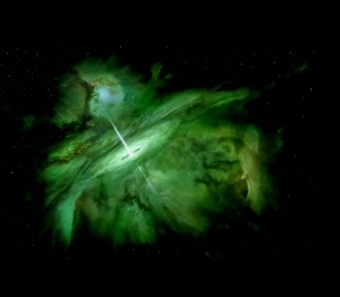
A Quasar is a specific type of astronomical object
formed by matter falling into a super-massive black hole. The resulting
energy is released as X-rays in all directions. However, the X-ray
release is most intense directly above or below the galactic plane.
Observed from this view, the resulting bright object is known as a
Quasar.
During the original five-year mission of the USS
Enterprise (NCC-1701), Captain James T. Kirk was under standing orders
to investigate all quasars, and quasar-like phenomena. In 2267, the
Enterprise encountered Murasaki 312, a quasar-like electromagnetic
phenomenon. (TOS: "The Galileo Seven")
In 2367 Worf informed Data about the long range
sensoring on the Murasaki 312 a quasar-like phenomenon. (TNG: "Data's
Day")
In 2370 Captain Jean-Luc Picard received a priority one
message from Admiral Blackwell inquires to the current status –
conducting surveys of the Mekoria Quasar. (TNG: "The Pegasus").
In real astronomy, Quasars are the most luminous objects
that we know of in the universe. Quasars were first identified as being
high redshift sources of electromagnetic energy, including radio waves
and visible light, that were point-like, similar to stars, rather than
extended sources similar to galaxies.
While there was initially some controversy over the nature of these
objects—as recently as the early 1980s, there was no clear consensus as
to their nature—there is now a scientific consensus that a quasar is a
compact region in the center of a massive galaxy surrounding its
central supermassive black hole. Its size is 10–10,000 times the
Schwarzschild radius of the black hole. The quasar is powered by an
accretion disc around the black hole.
|
